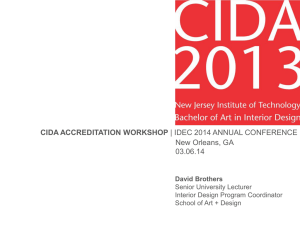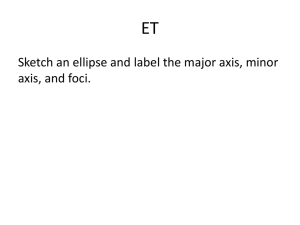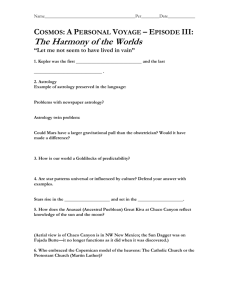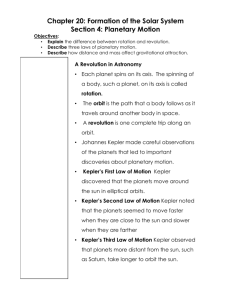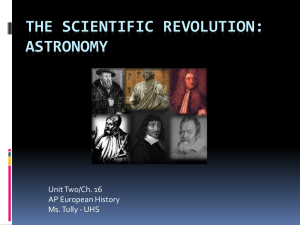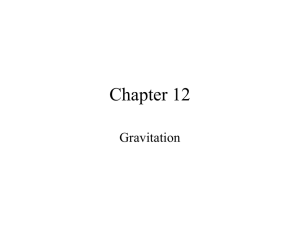Kepler`s New Pictorial Language of Scientific Representation
advertisement
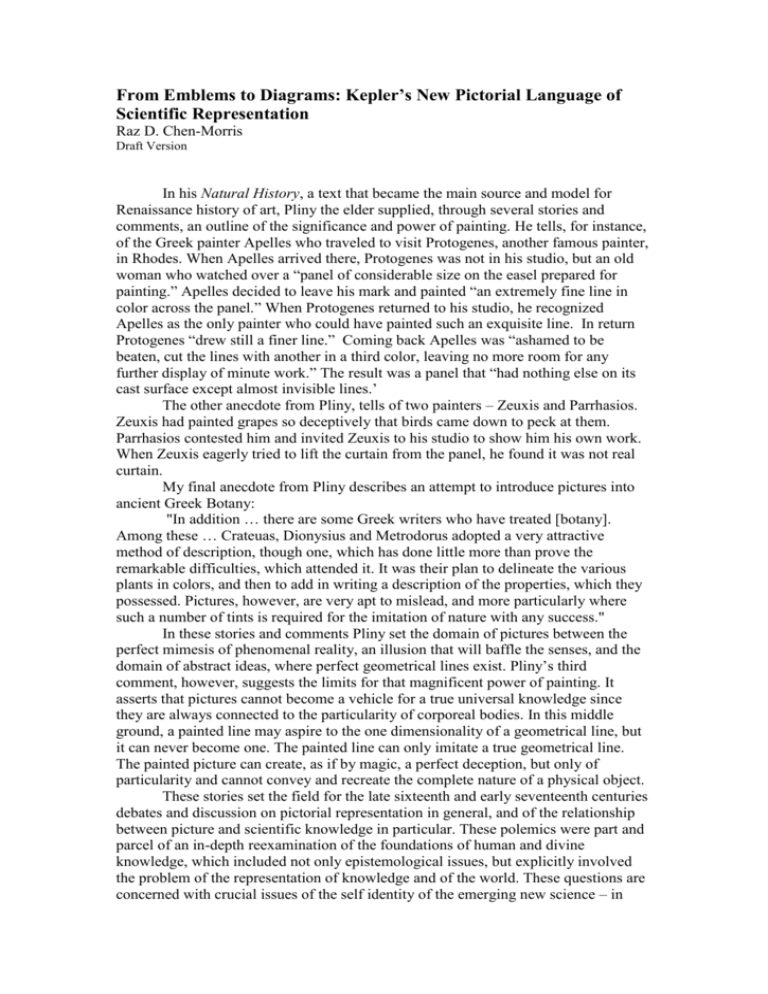
From Emblems to Diagrams: Kepler’s New Pictorial Language of
Scientific Representation
Raz D. Chen-Morris
Draft Version
In his Natural History, a text that became the main source and model for
Renaissance history of art, Pliny the elder supplied, through several stories and
comments, an outline of the significance and power of painting. He tells, for instance,
of the Greek painter Apelles who traveled to visit Protogenes, another famous painter,
in Rhodes. When Apelles arrived there, Protogenes was not in his studio, but an old
woman who watched over a “panel of considerable size on the easel prepared for
painting.” Apelles decided to leave his mark and painted “an extremely fine line in
color across the panel.” When Protogenes returned to his studio, he recognized
Apelles as the only painter who could have painted such an exquisite line. In return
Protogenes “drew still a finer line.” Coming back Apelles was “ashamed to be
beaten, cut the lines with another in a third color, leaving no more room for any
further display of minute work.” The result was a panel that “had nothing else on its
cast surface except almost invisible lines.’
The other anecdote from Pliny, tells of two painters – Zeuxis and Parrhasios.
Zeuxis had painted grapes so deceptively that birds came down to peck at them.
Parrhasios contested him and invited Zeuxis to his studio to show him his own work.
When Zeuxis eagerly tried to lift the curtain from the panel, he found it was not real
curtain.
My final anecdote from Pliny describes an attempt to introduce pictures into
ancient Greek Botany:
"In addition … there are some Greek writers who have treated [botany].
Among these … Crateuas, Dionysius and Metrodorus adopted a very attractive
method of description, though one, which has done little more than prove the
remarkable difficulties, which attended it. It was their plan to delineate the various
plants in colors, and then to add in writing a description of the properties, which they
possessed. Pictures, however, are very apt to mislead, and more particularly where
such a number of tints is required for the imitation of nature with any success."
In these stories and comments Pliny set the domain of pictures between the
perfect mimesis of phenomenal reality, an illusion that will baffle the senses, and the
domain of abstract ideas, where perfect geometrical lines exist. Pliny’s third
comment, however, suggests the limits for that magnificent power of painting. It
asserts that pictures cannot become a vehicle for a true universal knowledge since
they are always connected to the particularity of corporeal bodies. In this middle
ground, a painted line may aspire to the one dimensionality of a geometrical line, but
it can never become one. The painted line can only imitate a true geometrical line.
The painted picture can create, as if by magic, a perfect deception, but only of
particularity and cannot convey and recreate the complete nature of a physical object.
These stories set the field for the late sixteenth and early seventeenth centuries
debates and discussion on pictorial representation in general, and of the relationship
between picture and scientific knowledge in particular. These polemics were part and
parcel of an in-depth reexamination of the foundations of human and divine
knowledge, which included not only epistemological issues, but explicitly involved
the problem of the representation of knowledge and of the world. These questions are
concerned with crucial issues of the self identity of the emerging new science – in
2
what sense has the new science transformed the world into a picture, that is, the world
was transformed into a knowledgeable representation? How were the new means of
representation to be manipulated in order to produce new knowledge? Could such a
manipulation create new objects in the world? These are crucial matters especially in
demarcating the autonomous field of scientific knowledge from other forms and
practices that involve the production and application of knowledge in early modern
European culture.
Throughout the sixteenth century scholars and painters, alchemist and
theoreticians of art challenged the Plinian –Aristotelian assertions. Their attempt was
to reshuffle the new pictorial means (such as perspective) in order to form a scientific
language, constituted from visible signs, that not only represent human knowledge
and the physical world, but could also affect physical processes. Since this attempt
was made, however, still within the Aristotelian paradigm that a geometrical line is
conceived only in connection with a concrete, corporeal line (a line drawn ever more
finely), it preserved the unbridgeable dichotomy between concrete appearances and
the realm of knowledge.
In his treatise on optics of 1604 Kepler contrived a new pictorial language that
transcended this dichotomy inherent in the above stories between universal forms and
concrete appearances. Kepler’s solution was formulated in direct response to such
pictorial experimentation with emblem so popular at the turn of the 16th century. The
rich literature of emblems and especially the alchemical emblems offered fantastic
pictures as the vehicle to transgress the boundaries of forbidden knowledge through a
transmutation of the human gaze. Kepler, in contrast, transformed the visual depiction
into an exact representation of the motions of the universe, allowing thus for a new
and coherent picture of the world to emerge, while abandoning the claim for the
creation of a virtual-magical reality.
The aspiration of the literature of emblems was to challenge the gap between
human mental construction, which aspired to the realm of eternal forms, and the everchanging physical reality. It attempted to accomplish this through paradoxical games that
conflated together different level of interpretation with different systems of sensory
experience.1
The emblem was a focal point for different kinds of knowledge from different
sources. By being a verbal expression, a puzzle and a picture it enabled the reader to
bridge over gaps and inconsistencies in the different textual traditions. The emblem
enabled the concentration of a web of analogies, associations, and implications on the
different elements of the universe. In order to know something it is not enough to
conceive it as a phenomenon. One can fully recognize something only through its
diverse meanings, through the aphoristic wisdom embedded in it, and the different
textual contexts in which it appears.
The alchemical emblem attempts to combine in one picture the transmission of
knowledge, the explanation of its hidden meaning, together with the potency of the
image to create magical effects in the physical world as well as in the human psyche.
The emblem produced this effect by suggesting initially, a fictive, yet rigid, spatial
arrangement, that combined a dramatic and fantastic action within a schematic setting. It
further emphasized its paradoxical appearance by combining visible signs with verbal
puzzles, thus displaying different and only artificially connected sensory systems. This
paradoxical effect allowed the emblems to guide the reader to simultaneously different
and usually contradictory, levels of meaning and methods of interpretation. Lastly, the
alchemical emblem applied mathematical symbols as a means to combine a sense of
3
actual calculation, with allegorical revelation (usually as a mnemonic device) and a
demand to see visible signs as pointing towards higher and ideal realities.
One has to recognize each natural object by the metaphorical element contained
within it, as a symbol for spiritual and super-sensual ideas that constitute the divine
realms of the universe. As an example, I present here some emblems from Michael
Maier's Atalanta fugiens of 1617.2 Maier characterizes his treatise as:
"Partly adapted to the eyes and the intellect, with copper etchings, and added sentences,
Epigrams and notes, partly [adapted] to the ears and to the recreation of the soul with
less than 50 musical fugues in three voices ... to be seen, read, meditated, understood,
judged, sung and listened with particular pleasure."3
Maier's intention is the paradoxical combination of solitary contemplation and
application of sensual pleasure. The engraving as a visual device opens up for the
reader a treasure of texts, which in any other way would seem to contradict each other,
or to initiate an endless stream of different interpretations. The engraving together with
the aphorism and the enigmatic verse enable the contemplating reader to overcome the
gap between the two systems of representation, to integrate his sensual experience and to
guide his mind to that truth which is situated beyond his visual experience and beyond
the obscure ancient texts in which that truth was initially revealed. The emblem makes it
possible for the contemplative spectator to awaken his mnemonic powers, not in order to
induce fantasies of the sensual and material realm but to rise into that garden where roses
of philosophy bloom.
An additional element is the place and role of mathematical symbols in the
emblem and especially those symbols concerned with perspective. In late sixteenth
century art theory, "perspective"' became a complicated, somewhat obscure and highly
mathematized domain. It turned out to be an arcane and secret subject. Some of the
associations concerned with perspective turned out to be negative. Perspective became
associated with saturnine humours. However, it kept certain an ambiguity: the "corridor
space" suggests both the infinity of death as well as of Heaven.
A somewhat
different
symbolic
meaning is attached to
perspective in the
alchemical emblems.
For instance in an
engraving
of
the
magus
room
in
Heinrich
Kunrath's
Amphitheatrum
sapientiae from 1608,
a hall is depicted in a
strict
one-point
perspective.
This
method of depiction
creates the illusion of
progressing from the
musical
instruments
and measuring devices
in the foreground to
the alchemical furnace,
and then to the magus
4
who kneels in front of an altar of enlightenment within majestic a tent, where, with the
help of geometrical diagrams and combinations of Hebrew letters, he aspires towards
illumination. Finally the spectator's gaze is directed towards a window open to an
invisible world.
The same process occurs in the depiction of the gate leading to the doors of the
amphitheatre
of
eternal wisdom. A
tunnel is depicted
under a one point
perspectival
grid,
directing
the
spectator's gaze from
a world of visible
light to an invisible
world, yet illuminated
by a mysterious
source.
A
similar
structure
of
perspective appears
in Maier's treatise in
emblem number 8.
Here,
at
the
background of a
highly
theatrical
scene, in the back wall of the theatre's closed space, a vestibule opens up, depicted in one
point perspective, leading to an invisible area. The motto to this engraving reads "Take
the egg and pierce it with a
fiery sword".4 The epigram
continues and develops the
allegory. The egg is a source
from which, through the
combined help of Vulcan and
Mars, a bird would rise that
will conquer the realm of fire
and metals. 5
As with the other
emblems, the same kind of
complicated
web
of
associations and allegories is
knitted here, leading from the
Greek mythology to Christian
allegories and Alchemical
symbols dealing mainly with the transmutation of metals. The alchemical process,
according to the emblem and the discourse appended to it, is portrayed in analogy to
other processes of transformation: from an egg to a mature bird, from the womb to an
adult human, and especially from Maria's womb to divine perfection. The alchemist's
task is to follow these processes in his attempt to realize his aspired perfect control over
nature. The perspectivist vestibule guides and directs the reader from the material and
sensual gaze to a different kind of gaze, a perfected one, structured according to perfect
5
mathematical proportions. This gaze will be made possible when the egg is cracked open
in the material theatre from which the magus embarks on his way after supreme wisdom.
Thence, the meaning of the vestibule drawn in perspective is the transformation of
human cognitive processes and the shift to another form of consciousness and
awareness, which exists on a separate level of reality.
However, mathematical symbols acquire additional meanings in the emblematic
world. For instance in emblem XXI in Atalanta fugiens, the motto commands: "Make a
circle out of a man and a woman, out of this a square, out of this a triangle, make a circle
and you will have the Philosophers' stone." 6 The epigram develops further the symbolic
nature of the geometrical shapes:
"Make a circle out of a man and a woman,
From which a quadrangular body arises with equal sides,
Derive from it a triangle, which is in contact on all sides with a round sphere:
Then the Stone will have come into existence.
If such a great thing is not immediately clear in your mind
Then know, that you will understand everything, if you understand the theory of
Geometry."7
Maier asserts then that
geometrical shapes and their
manipulation acquire new meaning the squaring of the circle is a symbol
now of the unification of contraries.
The shapes themselves acquire a
dimension of sexual identity and
difference that the magus aspires to
transgress. One of the means the
magus can apply is the activation of
images and their combination, a
process that will affect and bring
about unification and harmony in
the universe - and vice versa,
processes in the universe (like the
creation of a super sexual being) will cause the squaring of a circle. Maier is following
here a tradition that took geometrical shapes as means to mobilize external forces. The
association between the geometrical shape and the natural object is not a quantitative
representation but a qualitative analogy. In other words, the geometrical figure itself
becomes an emblem that concentrates within itself a web of verbal, i.e., textual,
associations.
Until now, I pointed to two uses of mathematics within the emblematic world:
Initially, mathematical entities are conceived as causing and symbolizing the
metamorphoses of the magical gaze. The magical vision moves from the perception of
the material world into conceiving a different realm arranged according to pure
proportions. These proportions guide the contemplative eye to a higher sphere of being.
The other use of mathematical entities fixes them as symbols of magical
processes that cause the unification of contraries, or as talismans that concentrate in them
the powers of the universe - this is usually the case in Renaissance theories of astrology.
This utilization of mathematical symbols aims at influencing the material world itself. It
is the use of the knowledge acquired through the first process for the transformation and
salvation of the visible realm. The square and circle are abstract entities their meaning is
6
not easily recollected. Thus one's understanding of these geometrical figures must go
beyond their quantitative aspect. Recollecting the essence of geometric shapes will lead
to the understanding that a square is not a mere theoretical quantity but actually a symbol
for the chemical qualities of the four elements. The circle is not merely a visual shape
but the symbol of the simple body. Thus, the process described in the emblem is not just
the squaring of the circle (which Maier claims the natural philosophers knew) but an
alchemical process in which the four elements are transformed into three: body, spirit
and soul. These in turn correspond to the three primary colours: The earth or material
body is black (the colour of Saturn). The spirit is water and appears in the whiteness of
the moon, and the soul, as the air, is the yellow colour of the sun. The triangle must be
transformed into a circle, which is unity, and its colour is red. This is the process through
which a woman turns into a man to become unity. In such a way, the numbers are
perfected by One that is "rest and eternal peace".8 Through the contemplation of these
analogous processes the initiate will advance towards true enlightenment.
The alchemist perceives the natural world to have deteriorated from its initial
divine grace and perfection. Nature has been corrupted and disintegrated as a result of
human original sin. This lapsed natural state is not limited only to the sub-lunar realm:
Many philosophers, during the sixteenth century, watched with anxiety how decay and
corruption spread to the eternal heavenly bodies. Fludd and his circle saw in this state of
affairs an urgent call for an extreme effort to save the universe. Maier, following
Paracelsus and other alchemical theoreticians, conceived the transmutation of metals as a
salvation of their primary, exalted and divine nature. The task of the alchemist is to
retrieve and recollect these memories of the divine Creator's act that are enclosed within
fallen matter. The process Maier describes, takes place on two analogous levels in the
human mind and in physical nature. Contemplating emblematical scenes initiates a
mnemonic process whereby the human mind dissociates itself from the material world to
gaze instead on spiritual and divine essences. The human contemplator aims for the
retrieval of divine sparks, which were imprisoned in the material realm of bodily
passions, and for their reunion with their divine origin. This process is complimented by
the alchemical transmutation of metals whereby debased metals are transformed back to
their noble and golden essence. These two processes are connected, each reflecting the
advent of the other. The alchemist experiments with fire in the material realm to inspire
and induce the mental processes and vice versa. Thus the salvation of Nature will take
place simultaneously with an apocalyptic salvation of the human race.
The alchemical emblems tackled the Aristotelian gap between the realm of
concrete visual signs and the realm of universal concepts by turning this gap into a
paradox, into a serious play. In this play the serious conclusions are always ephemeral,
always hinting that things are not what they seem, and that any serious truth arrived at,
will evaporate immediately in front of the frustrated gaze of the sinful human mind.
In order to understand this ambiguity of the emblem as a mnemonic device on
the one hand, and as pointing beyond memory to the source of divine wisdom on the
other, one has to look into the psychological system of vision as Fludd presents it.
Overlooking it may foster a misunderstanding of Fluddian rhetoric, as if Fluddian
science envisions a proto-empiricist scientific method.
In the second volume of his monumental work dealing with the history of the
Microcosm, Fludd gives an idiosyncratic account of the triple division of the soul's
vision. This account combines a strange mixture of Neoplatonic, Hermetic and an
awkward version of Aristotelian psychology. The first stage in the soul's visual
perception is the corporeal vision that perceives the colours and dimensions of the
external bodies.9 The soul needs this corporeal dimension since otherwise it is not able to
7
perceive the external physical reality due to itself being an invisible and spiritual
substance. The second type of vision discerns the spiritual images of the corporeal
bodies10. Although these images originate from material bodies, Fludd names them
spiritual because they do not posses a body. Furthermore, for Fludd the process through
which these images are created is an occult power that enables the external bodies to
express themselves in the same manner as images are produced in a mirror.11 The third
type of vision is the intellectual vision that aims at a realm beyond the physical world
and perceives the truth itself.12
The next step is to put these three types in an ordered hierarchy according to their
cognitive value. In contrast to Aristotle in De anima, who assumes the proper sensual to
be infallible, Fludd declares that the material sense of vision itself is responsible for
errors of perception in the soul.13 Fludd gives different and topical examples of visual
errors from the sailors who imagine the shore to withdraw to the stick that appears to be
broken in the water. Fludd concludes this section by denigrating vision as a prime
deceiver of the soul: "Immo vero inter omnes alios sensus maxime visus, quamvis
praestantissimus, decipitur".
All these matters are treated in the science of optics. However optics does not
seem to solve the problems concerned with visual deception but only to trace the
problems and the extent of visual illusions in human daily experience.14 Fludd rejects
then the Aristotelian definition of proper sensibles, and locates the visual distortions in
the eye itself and not in the judgement of the soul. Moreover, the soul can adjust (as well
as produce) these distortions by using the science of optics and perspective.
It is clear, then, since the power residing in the more spiritual elements of the
soul is greater than in the senses concerned with material reality as such, that the
distortions produced in the spiritual parts are more potent and with more lasting effects.
These distortions not only cause the soul to fail but also bring suffering and
aggravation.15 The principle, which guides and moulds these effects, is that the second
type of vision is concerned not with the things in themselves but with their similitude
and the mind perceives these simulacra as in a polished mirror. However, these images
are not only the product and expression of things in themselves but are their reflection,
the image of these things exerted from the unreliable external senses.16 It is through this
type of vision that one discerns the three dimensional outlines of the corporeal world and
it is the place where the images of the celestial bodies and of the zodiac are constructed.
However, Fludd is careful to emphasize the difference between this spiritual vision and
the intellectual vision. The latter can never err and is always contemplating those higher
realities, such as "Deus, mens rationalis et intellectualis, ratio, virtutes cardinales,
castitas, pietas et quaecunque alia sunt eius generis," whereas, through the former type
of vision one sometimes acquires correct perceptions and sometimes wrong perceptions.
Thus, the spiritual vision sometimes agitates the soul and sometimes brings it to
tranquility.17 The main cause for this problematic state of affairs is the fact that the spirit
is not a body but participates in the bodily qualities either by being the form and
similitude of the body or by participating in the nature of the lower and material kind of
light. While one is sleeping, the more agitating effects of the spiritual imagination are
revealed in sexual dreams and nocturnal emissions of semen.18 The imagination,
although it may have some cognitive value, is more dangerous and false than the
external senses because it can move the flesh while the normal inhibitions are weakened
in sleep. Thus, even the chaste and more religiously minded people are not protected
against its evil temptations.19 For if the soul adheres to the superior mind then its vision
is turned to more mental and intellectual pursuits. However, when the soul is subjected
more to the sensual elements of cognition then it employs more of its inferior vision. If
8
one attempts to gaze at the Truth, one must first release the middle spirit from its
corporeal temptations, and from its inclination toward the material. Fludd implies the
means for liberating the soul from the grip of material passions in his discussion of
dreams. While for the most part dreams, the hallucinations of the madman, or day
dreaming are just a re-enactment of daily material bodies and desires, there are certain
kinds of dreams and visions in which one is not viewing external and material bodies but
the spiritual content of the soul itself. In this kind of internal vision, the soul perceives
not those simulacra it received from external bodies but it inspects its own inner forms in
themselves. In order to achieve this kind of vision, Fludd testifies that he contemplates
remarkable emblems (admiratio insigni), that bring him to amazement and wonder. This
vision is disconnected from the material corporeal vision: "Yet, whatever the nature of
that vision is, it is for certain not corporeal. For no [corporeal] body produces those
images in the spirit. Nor has it this power to shape something spiritual; but the spirit by
itself presents it in its own wonderful speed, as one might expect of [something]
spiritual, intellectual or rational".20
According to Fludd the material eye can produce no meaning but meaningless
visual impressions; it gazes at the passing reality and receives its shadowy impressions,
which become pictures in the internal eye of the spirit, where fantasies retain the content
of one's memory. However, as long as this pictorial content is associated with the
external world, it has dangerous implications. It excites the human imaginary power to
false dreams and moves the human psyche mainly in the direction of sexual stimulation.
Thus it moves one's mind away from its aspiration to wisdom and truth. The only way to
turn the human internal mind away toward the superior domains of true wisdom is by
arousing the spirit's inner content and kindling the intellectual eye. This can be
performed by refurnishing the theatre of memory with pictures and buildings that have
no origin in the external and sensual world. The emblem although it has a sensory
aspect, by being a fantastic picture, divorced from ordinary human experience, allows
the spiritual eye to overcome sensual temptations and to turn towards intellectual
contemplations of the Godhead.
Yet, although the stakes are high, and the promise of the alchemical emblem was
tempting, at the heart of this tradition was an epistemological obstacle. The gap between
the concrete phenomenon and the realm of universal concepts was preserved with the
sense of playfulness that while bringing the particular and the universal ever so close,
still always left the spectator/reader of the emblem in uncertainty: was it a glimpse of the
Truth or just another level of allegory one has reached?
******
In order to surmount the gap between knowledgeable universals and physical
reality Kepler had to redefine both the relationship between geometrical figures and
the phenomenal realm, and the ontological and epistemological status of pictures.
Kepler turned on its head the process of abstraction and with it the process by which
mathematical entities originate.
9
This is neatly exemplified in Kepler’s treatment of the conic section.
According to A. E. L. Davis Kepler's system is "the first 'non-cone-based' system of
conics."21 J. V. Field specifies that: "Apollonius had in general treated the conics as
separate, though related, curves. Kepler seems to have been the first mathematician to
describe the conics as forming a system, that is, to attempt to give a unified account of
their properties"22 Kepler's main move was to consider the sections not as specific
abstractions of specific sectioning of a specific cone but to emphasize the analogical
relationship between them. Thus instead of the plane cutting a cone he concentrates
on the foci (probably a linguistic invention of Kepler). His system "passes from a
straight line through an infinite number of hyperbolas to the parabola, thence through
an infinite number of ellipses to the circle."23
Kepler goes on and explains how the single focus of the circle and the two of
the ellipse are related and continues that:
"In the parabola one focus [D in Kepler's diagram] lies within the curve, while
the other is represented either outside or within it on its axis at an indeterminate
[infinite] distance from the first, so far that a line [either HG or IG in the said
diagram] drawn from that blind focus [at either end] to every point of the curve [G] is
parallel to the axis [DK]."24 Kepler can now complete his system of analogies: "It
follows
by
analogy that, for
the straight line,
the focus (as we
will use the term,
in relation to the
straight
line,
without precedent,
to complete the
analogy) in both
cases
coincides
with the line itself,
so that there is
only one focus, as
for the circle.
Then in the circle
the focus is at the
centre itself - the
point furthest from
the circumference - in the ellipse it is less far from the circumference, and in the
parabola much less, in the end being the minimum distance away: that is, it falls on
the line itself."25 Moreover while Kepler attempts to present a method for its
construction this method and the a-priori reasoning that bring this system into being
are not enough to make it meaningful. This system will be meaningful only if the
mind is able to recognize these curves in the movements of the physical world that is
as a surface that would turn into parallels all rays emanating from a fixed point and
will describe a pattern of the angles of refraction.
Kepler’s new conception of light as a principle of physical motion and not as
an emanation from the realm of Ideas, supplied him with the grounds for a thorough
critique of the emblematic pictorial language of late sixteenth century alchemy. The
emblems attempted to bridge over the gap between abstract ideas and concrete
10
appearances through a paradoxical application of sensuous picture that will lead the
spectator into the experience of an intellectual and spiritual truth.
In order to solve and overcome these difficulties Kepler had not only to
transform geometrical entities into a representation of motion, but also to redefine the
essence of a picture, and to align it with a new theory of cognition, and finally to
reassign the playing mode to the process of an serious enquiry after the physical truth.
Kepler's definition of picture appears in Chapter V of Ad Vitellionem
paralipomena: "Whereas up to now an image has been [considered] a rational entity,
now figures of objects truly existing on paper, or other screens, are called pictures."26
Kepler preserves this difference between real and virtual optical effects and defines the
image as "when an object is seen, with its own colors and parts, but not in its own
place, not showing the proper quantities, and its parts holding wrong proportions. In
short, the image is the vision of a certain object linked to an error of the faculties
concurrent with vision. The image itself, therefore, is hardly anything and it would
have been better called an imaginary fabrication. It is something made up from the
species of real color and light and [from] intentional quantities."27
Chapter V of Ad Vitellionem paralipomena, the summation of Kepler's optical
arguments, begins by emphasizing and rehearsing the epistemological context of his
optical discourse. "The astronomers place at the foundation [of their science] the
diameters of the luminaries and the quantities of solar eclipses; now, some visual
deception is produced, partly from the conduct of the observation, which we discussed
in chapter 2, above [i.e., where Kepler discusses the formation of images in camera
obscura], partly from simple vision itself: …as long as the latter is not dissipated, it
would create considerable difficulties for the astronomers and diminish their judgment
capacities. Therefore, the occasion of such errors in vision has to be investigated, and
that according to the shape and functions of the eye itself."28
The main part of the fifth chapter, dealing with human eyes and sense of sight, is
devoted not to anatomical data but to adjusting Kepler's optical theorems to a particular
set of experiments. Kepler details the experimental context immediately after he
summarizes his anatomical description of the eye's structure. The anatomical backdrop
is utilized to isolate the two main components that produce the sensation of vision,
namely the crystalline humor and the retina.
Kepler discusses two fundamental phenomena in this context: the appearance of
a picture on a paper placed behind a crystal ball or a glassy urinary flask filled with
water placed against a window in a room; and the disappearance of the picture when
the eye is positioned where the paper was before. Kepler asserts that the main factors
responsible for these phenomena are the refractions of rays of light and the convex
shape of the glass globe filled with water [Haec omnia fiunt circa globum aqueum,
propter refractiones et figuram, eo quod convexitas aliqua insit figurae]. In the
following propositions, he attempts to explicate these phenomena and especially to
delineate the psychological factors that determine the disappearance of the picture on
the paper and the appearance of images on the surface of the ocular lens (namely, the
crystalline globe]. Thus, the presence of the eye transforms one's optical experience
and turns a physical picture into a mere image. Kepler's first step is to explain the
image as a psychological phenomenon dependent on the activity of the eye. Initially he
proves that, following his catoptrical propositions, the geometrical locus of the image is
between the eyes and the globe. The problem arises as to why the eye sees the image
on the surface of the globe and not in mid air where it appeared before on the sheet of
paper. The answer is that "there is no place in front of the ball or globe of water for the
image of a thing hidden behind the ball." 29 The reasons for this are wholly dependent
11
on the natural disposition of the eye. Kepler defines three factors, physical and organic,
functional and psychological.
The physical reason is defined in proposition 2: "Vision perceives with more
difficulty the nearer [objects] than the remote ones." Since the eyes tend to preserve
their parallel position, any attempt to perceive a nearby object strains the eyes to turn
and to contract toward it. 30
The second factor is the natural disposition and function of the eyes to perceive
light: "Vision is attracted by brilliant objects, but it is hardly drawn to fleeting and
feeble things." This disposition derives not only from experience but also from the
essential property that sight is moved by light. Thus, the stronger the light the more
agitated the eyes are. Therefore, the eyes follow the stronger illumination at the
expense of the lesser-illuminated areas.31 The last factor is the ability of vision to
actively create images. This ability is destroyed by strong light that diverts the beholder
from the supposed location of the image. Thus, Kepler proves that the image cannot be
seen between the eyes and the globe because the eyes are attracted to the illumination
coming from the globe. Furthermore, this illumination will overpower and disperse the
image.
This analysis leads Kepler to define the image as an intentional entity that the
sense of sight creates as an active agent. The human mind is forced to supplement the
missing data that the sense of sight is unable to perceive, not because of the external
environment, but on account of its own disposition. In these cases, the mind naturally
constructs the mathematical ratios that would inform visual reality and would present it
coherently. Kepler provides an explicit case of such kind in his catoptrical discussion.
Since the eyes cannot perceive the point of reflection [or refraction], the mind has to fill
in the sensual data and structure them geometrically. He contends that this is the reason
for one's perception of the image over a perpendicular line drawn from the object to the
mirror. As he showed in the catoptrical part of the treatise, the perpendicular line is not
produced either by the object or by the form of the mirror's surface, but is a mental
construct:
"For nothing concerns the location of the image, other then the surface of the
mirror opposing the object, since all the reasons for the formation of images
are obtained from that part of the mirror, in which are the two points of
reflection to the two eyes. Therefore, the cause why the location of the image
is along that perpendicular is in this part of the mirror, and not in the
perpendicular [drawn] from the object itself. Accordingly, it is necessary to
represent mentally the ratio of the curvature, produced by the refraction, as a
complete circumference, and in order to define the location of the image, a
perpendicular from the [visible] object is drawn over this imaginary sphere."32
Illusions are not games played by nature in order to delude the human mind. On the
contrary, the limited nature of the human senses forces the mind to play and to invent
the mathematical constructions that produce an intelligible visual reality. While an
image is determined by the natural disposition of the human mind and of the human
sense of sight to produce a coherent perception of reality, it depends for its particular
appearance on a concrete set of physical circumstances.33 The convergence of the
mind's compulsion for mathematical regularity and of the particular physical and
psychological conditions cause the image to appear "confused and doubled" [confusae
et geminatae]. Hence the meanings of Kepler's terminology "Ens rationale," "Ens
intentionale" and "quantitas intentionale" are all intended to emphasize the active and
inventive role vision plays in rationally producing an optical image. The difference
between an image and a picture does not concern the process through which they are
12
produced mathematically or physically but only the psychological aspects that force
the mind to actively complement its sensual data. The picture is a passive product of
the visual process and this passivity secures its epistemological status as a true
depiction of visual reality.
"Therefore, since illumination is an action, and since vision is not an action
but a passion, the contrary of an action, for the places to correspond, it is
necessary that the regions of the patient and the agent be opposite. However,
the places are perfectly in opposition when the same center is shared by all
opposing lines which will not happen if the picture were erected.
Accordingly, in an inverted picture, although universally and in respect to
some common line, right and left are exchanged, still the right [part] of the
object is perfectly opposed to the right part of the picture, and the higher part
of the object to the higher part of the picture (considered in itself) so also the
curve to the curve. There is nothing to fear, that sight will err in the area. …
Rather, if the picture were to be erected, then vision would have been misled.
…Therefore nothing absurd is committed by [assuming] an inverted
picture…"34
In the process of image formation, sensual data is lacking or obstructed (the eye
cannot perceive the point of reflection, or strong illumination erases other optical
phenomena). However, in the formation of an optical picture all data (external to the
eye) arrives at the retina. Moreover, since the picture preserves the mathematical
arrangement of the visible object, there is no need for the mind to complement it
with imaginary geometrical constructs in order to produce a coherent perception of
visual reality. The mathematical regularity of the inverted picture vouchsafed against
any mistaken identification of place or area.
The medieval theorists defined species as the direct physical impression on the
eye that travels along perpendicular lines to the crystalline humor. They
differentiated between species as physical effects and images that are imaginary
constructs governed by geometrical laws of reflection and refraction. Kepler's
images, however, while still products of the human imagination did not differ from
pictures in their formative process, both being the result of refracted/reflected rays of
light. The difference rests in the entirety of the visual data supplied by the process.
In picture formation, all the reflections/refractions take place within the eye thus
preserving their geometrical arrangement, though still finally producing an inverted
picture. In image formation, some data are missing and the intervention of the
human imagination causes the final result to be a certain artificial entity, where
things are not what they appear to be.
Keplerian inner imaging is responsible for visual distortions and errors. The
mathematical arrangement supplied by the process of reflections and refractions of
light and color within the eye can produce meaningful pictures of external reality.
Kepler recognized the power of the human imagination to inform one's perception of
reality. However, he aspired to limit this power and to supply the criteria for
differentiating between real and false perceptions. Initially, he assumed that physical
reality tends to express itself through geometrical figures and regularities. Thence, the
human senses respond to these geometrical forms, since these senses are formed
according to the geometrical archetypes that reside in the human mind. Only when the
human mind recognizes its own archetypal content in the sense data, can the true
knowledge of reality become possible. In other cases, when objects are perceived
through reflecting or refracting surfaces, the visual data are incomplete and the mind
enforces its own geometrical constructs in its perception of the world and thus creates
13
chimeras and false images. Only a geometrical correspondence between physical
reality (as it is represented by the geometrically governed propagation of light) and
the mind's inner geometrical archetypes can create true knowledge. Any attempt to
deny one of these components results in meaningless and ludicrous games and
illusions. Therefore, while accepting the Platonic description of the mind as an inner
painter, Kepler summons the painter to respond to the visual demands of the material,
sensual, and geometrically regulated world.
Kepler's pictures are the products of refractions; they are not emanations from the
visible object itself but are produced by light as an external agent and colors (which,
as already noted, are quanta of light hidden within the object's matter). Thus, the
retinal picture is a doubly mediated (i.e., reflected) appearance of the visible object.
The result of the visual process is an inverted and reversed picture of the external
object; that is, the parts on the right are now on the left and those at the top appear at
the bottom. For the medieval and renaissance sensibilities, Kepler's retinal picture is a
distortion on the verge of a chimera, or a monstrous depiction of reality. What saves
the retinal picture from absurdity is the geometrical regularity of the inversion of the
retinal picture. The stable center, through which pass all the lines from the
corresponding points on the object and on its inverted picture, limits the mind's ability
to play with the sensual data and thus guarantees one's visual knowledge. In a sense,
Kepler's retinal picture is a sort of a "serious joke": though it represents the world
upside down, it allows one to perceive the truth. However, artistic jokes in the manner
of Arcimboldo are human creations that suggest playful leaps between multiple levels
of meaning and signification. Thus, their truth is hidden and evasive. In contrast,
Kepler's retinal pictures are natural creations and thus limit human creative
playfulness and, by their geometrical regularity allow only one true depiction of
visual reality. Kepler asserts that unlike the human mind, "Nothing designated by
Nature is wasted."35 He differentiates between the realms of human creativity and
natural truth. While the first produces illusions that are the result of epistemological
uncertainty, the latter, when carefully analyzed, exhibits geometrical regularity and
certitude.
Kepler turns the meaning of serious play on its head. Instead of a game that always
exemplifies the gap between visible phenomena and the realm of knowledge,
always leaving the players wondering between several options for interpretation and
meaning, Kepler’s game results in one definite and clear solution:
"I too play with symbols and have planned a little work, Geometric Kabbala,
which is about the Ideas of natural things in geometry; but I play in such a way that I
do not forget that I am playing. For nothing is proved by symbols; no hidden thing is
brought to light in natural philosophy, through geometrical symbols, things already
known are merely fitted [to them]; unless by sure reasons it can be demonstrated that
they are not merely symbolic, but are descriptions of the ways in which the two things
are connected and of the causes of these connections." 36
Kepler succinctly summed his position in regards to emblem in an
epigraph he wrote on the margins of his own copy of an emblem book. There
opposite the picture of the falling Icarus, Kepler commented: "Nemo cadit,
recubans, terrae de cespite planae; Ocuras hominum, o quanta est in rebus
inane."37 The emblem of Icarus warned against the search after forbidden
knowledge, epitomized in the practice of astrologers aiming both to calculate the
paths of the celestial bodies and to foresee the future of human affairs. Kepler, in
contrast, differentiates sharply between the search for knowledge and the magical
motivation. One must leave the flat earth and aim at the laws that govern the
14
universe, yet any attempt to ascribe meaning to the tupsy-turvi human world of
misfortune and chance accidents is futile.
Keplerian pictures are a means of acquiring knowledge because of their
geometrical regularities. They are transformed into diagrams. Yet, these diagrams
are not abstractions from static corporeal bodies but representations of possible
motions and the relationship between those motions of physical bodies. A
Keplerian line does not have to be ever more fine in order to remind the observer
of a true geometrical line. It has to be only accurately calculated, so it can convey
the exact path of a possible motion of a physical body in space. By relegating the
emanation of visual signs from a motionless corporeal reality, i.e., by discarding
the mimetic aspect of pictures, Kepler liberates scientific pictures to become exact
human-made representations of disembodied motions.
1
The emblematic tradition had emerged from the Renaissance interest in hieroglyphs, Roman coins and the
symbols impressed on them, and from fables and epigrams collected from classical sources. The original
aim of the "inventor' of the emblematic literature, Andrea Alciati (1492-1550), was to compose epigrams
especially enigmatic, so the readers would feel a pleasant and surprising enlightenment when they would
have succeeded in solving them with the help of the attached interpretation. Alciati's original plan did not
include an adjusted picture to the written epigram, but when the Emblemata was first published in 1531,
engravings were added, and in mid-century the visual picture was an integral part of the emblem. The
emblem itself included three parts: a visual picture, a short motto, and a somewhat longer epigram. In an
ideal epigram all the components were necessary, but not sufficient, for a complete understanding, and only
the combination of the components together enabled a useful and pleasant moral insight. The emblematic
tradition has flourished all over Europe. Alciati's book came out in dozens of editions and extensions,
and these brought about dozens of other books of emblems. Around 1600 hundreds of emblem books
were in print and this flow kept growing until, around mid-century, it started to recede.
2
Michael Maier, Atalanta Fugiens, hoc est, Emblemata nova de secretis naturae chymica (Oppenheim,
1617). In my interpretation and traslation of the following citations I followed H. M. E. De Jong, Michael
Maier's Atalanta Fugiens: Sources of an Alchemical Book of Emblems (Leiden, E. J. Brill, 1969), unless
specified otherwise.
3
Accommodata partim oculis & intellectui, figuris cupro incosos, adjectisque sententiis, Epigrammatis &
notis, partim auribus & recreationi animi plus minus 50 Fugis Musicalibus trium Vocum, ... singulari
jucunditate videnda, legenda, meditanda, intelligenda, dijudicanda, canenda & audienda" {My transaltion}.
4
Accipe ovum & igneo percute gladio
5
Est avis in mundo sublimior omnibus, Ovum
Cujus ut inquiras, cura sit una tibi.
Albumen luteum circumdat molle vitellum,
Ignito (ceu mos) cautus id ense petas;
Vulcano Mars addat opem; pullaster & inde
Exortus, ferri victor & ignis erit.
6
Fac ex mare & foemina circulum, inde quadrangulum, hinc triangulum, fac circulum & habebis lap.
Philosophorum.
7
Foemina masque unus fiat tibi circulus, ex quo
15
Surgat, habens aequum forma quadrata latus.
Hinc Trigonum ducas, omni qui parte rotundam
In Sphaeram redet: Tum Lapis ortus erit.
Si res tanta tuae non mox venit ob via menti,
Dogma Geometrae si capis, omne facies.
8
These three elements correspond to Dee's conception of three grades in the advent of the initiate towards
perfection and wisdom: The realm of pneumaticus (the spiritual) is divided into three levels. Leading from
the philosophos associated with the element of water, and having a 'taste of the fundamental truths of
natural knowledge". The sophos follows - this grade is associated with the element of air. He explores the
"celestial influences" and "the reasons for the rise, condition, and the decline of other things". Finally
reaching to the Adeptiuus who is associated with the element of fire and aspires to explore and understand
"the supernatural virtues and metaphysical influences". See C. H. Josten, "A Translation of John Dee's
Monas Hieroglyphica (Antwerp 1564), with an Introduction and Annotations," Ambix 12 (1964), pp.11421, and Nicholas H. Clulee, John Dee's Natural Philosophy: Between Science and Religion (Routledge,
London and New York, 1988), pp.81-2.
9
"Tria visionum in anima esse genera ab effectu infalibili animadvertimus; quorum primum est corporale,
quo per corporis sensus corpora rerum colorata eorumque dimensiones & alia sensibus obvia percipiuntur"
(Fludd, Utriusque Cosmi Maioris, Vol. II, tractatus primi, sectionis I, liber X, p. 204).
10
"Secundum visionis in anima genus spirituale est , quo corporum similitudines spiritu solummodo, et
non ratione seu mente, cernuntur" (ibid.).
11
"Idcirco quadam vi occulta & spirituali ita rapitur anima, ut loco corporum expressas eorum
similitudines, tanquam in speculo videat" (ibid.).
12
"Tertium visionis genus est intellectuale, quo res illae, quae nec corpora, nec corporum formas habent,
conspiciuntur; quales sunt, ipsa mens, Deus, justitia, sapientia & omnis animae affectio bona" (ibid.).
13
"In visione vero corporali quam saepissime errat & fallitur anima, secundum vetus illud et verum
axioma philosophorum: sensus fallitur circa proprium et verum objectum, cum in ipsis corporibus fieri
putat, quod videtur apparere in phantasia" (ibid.).
14
"Atque sic in caeteris infinitis, de quibus opticae scientiae periti luculenter egerunt; Imo vero &
nosmetipsi in scientia nostra optica, in libellis de radiis refractis & reflexis haec omnia succincte & unico
quasi verbo delineavimus ... Ex quibus evidens est, quod visio illa animae corporalis, quae sensibus
exterioribus pro organis suis utitur, circa objecta corporea fallatur. Atque hic est primus visionis in anima
gradus, quo corpora sentimus, quam quidem functionem anima per quinque corporis sensus expedire solet"
(ibid.).
15
"De secundo gradu visionis animae, quae est in imaginatione seu phantasia, et ... anima in ea
nonnunquam fallatur, patiatur, atque aggravari videatur" (ibid.).
16
"Secundo genere visionis animae, quo non corporea, sed corpori similia, atque adeo etiam nosmet ipsos
non aliter, quam corporibus similes, intuemur, res in spiritu phantastico conspiciuntur, quemadmodum
imago in speculo politissimo. Atque ut imago corporis in speculo se habet ad corpus; quod extra speculum
existens, imaginis figuram sua praesentia exhibet: sic etiam corporum a sensu externo visorum icones atque
effigies spiritui imaginationis imprimuntur" (ibid., pp. 205-6).
17
"Sed & fallitur anima in visione spirituali, de qua his agemus, atque illuditur; quoniam ea, quae videt,
aliquando vera, aliquando falsa, atque nonnunquam perturbata et interdum tranquilla sunt" (ibid. , p.206)
18
"Hinc igitur apparet, animam non esse corpoream, sed potius corporis quasi similitudinem, quae non
est corpus; quaeadmodum spiritus non est corpus, sed de corporis & lucis natura participans, quoniam
dormienti & in somno alicui veluti corporeus apparebit, neque tamen id corpus eius est, sed anima, nec
verum corpus, sed similitudo corporis eius. Jacebit enim corpus eius, ambulabit anima; tacebit lingua
corporis ejus, ac loquetur ipsa; causi erunt oculi tui, videbit autem tem illa; & ita in ea tota ac integra
cernetur similitudo carnis ejus. In hac similitudine quasi per loca cognita & incognita discurrit, et sentit
16
laeta vel tristia ... Unde saepe imagines rerum corporalium tanta expressione obiiciuntur in somnis, quanta
praesentantur ipsa corpora vigilantibus, in tantum quidem, ut etiam inter visionem dormientium et veram
cognitionem vigilantium non discernatur, sed continuo iis caro moveantur,& contra proposititum suum, vel
contra mores licitos, concumbere sibi videantur, ac quod naturaliter collectu est, per genitales vias emittant;
quam quidem actionem medici nocturnam pollutionem nuncuparunt" (ibid., pp.206-7).
19
"Hunc motum casti vigilantes cohibent et refraenant, quem dormientes ideo compescere non possunt,
quia in potestate non habent imaginis corporalis expressionem, qua caro naturaliter movetur, unde sequitur
illud, quod cohibitum sequi solebat, et quod sine peccato a vigilantibus fieri non potest, sit in spiritu, et
multa pro arbitrio finguntur, vel praeter arbitrium demonstrantur, dum corporalium rerum imagines
apparent. Ipsa namque anima, quae motu proprio semper in motu est, quia a corpore non sinitur, etiam
plane non sinitur corporalia sentire, aut ad corporalia vim suae intentiones dirigere, idcirco, corpore sopito,
spiritu ipsa agit, sicuti imagines corporum cogitando ex seipsa versare assolet, aut subjecta intuetur, cum ad
ea videnda aliquo spiritu assumitur" (ibid., p.207)
20
"Qualiscunque tamen illa visorum natura sit, procul dubio corpus non est. Non enim corpora visa illas
imagines in spiritu faciunt, nec eam vim habent, ut aliquid spirituale forment; sed ipse spiritus in seipso
celeritate mira id praestat, utpote spiritualis, intellectualis atque rationalis"(ibid., p.208).
21
A. E. L. Davis, "Systems of Conics in Kepler's Work," Vistas in Astronomy 18 (1975), pp. 673-85.
J.V. Field, "Two Mathematical Inventions in Kepler's 'Ad Vitellionem paralipomena'," Studies in
History and Philosophy of Science (1986) vol. 17, no.4, pp. 449-68.
23
"Quod a linea recta per Hyperbolas infinitas in Parabolen, inde per Ellipsis infinitas in circulum est
transitus." GW vol. 2 p. 90
24
In Parabole vnus D est intra sectionem, alter vel extra vel intra sectionem in axe fingendus est
infinito interuallo a priore emotus, adeo vt educta HG vel IG ex illo caeco foco in quodcunnque
punctum sectionis G. sit axi DK parallelos." Ibid., p. 92
25
“Sequitur ergo per analogiam, vt in recta linea vterque focus (ita loquimur de recta, sine vsu, tantum
ad analogiam complendam) coincidat in ipsam rectam: sitque vnus vt in circulo. In circulo igitur focus
in ipso centro est, longissime recedens a circumferentia proxima, in Ellipsi iam minus recedit, et in
Parabole multo minus, tandem in recta focus minimum ab ipsa recedit, hoc est, in ipsam incidit." Ibid.,
p.92).
26
"Cum hactenus Imago fuerit Ens rationale, iam figurae rerum vere in papyro existentes, seu alio
pariete, picturae dicantur" (Kepler, GW, vol.2, P. 174). The definition is problematic since nowhere
before did Kepler supply the term "rational entity" with a definition. Thus, the contrast between these
two modes of imaging is not at all clear.
27
"Dicunt enim imaginem Optici, cum res ipsa quidem cum suis coloribus et figurae partibus cernitur,
sed situ ali … alicubi et alienis induta quantitatibus et partium figurae proportione inepta. Breviter,
imago est visio rei alicuius, cum errore facultatum ad visum concurrentium coniuncta. Imago igitur per
se pene nihil est, imaginatio potius dicenda. Res est composita ex specie coloribus vel lucis reali, et
quantitatibus intentionalibus" (Kepler, GW, vol.2, p. 60).
28
Dum diametri luminarium et quantitates Solis Eclipsium, fundamenti loco annotantur ad Astronomis:
oritur aliqua visus deceptio, partim ab artificio obseruandi orts, quam supra cap. 2. Discussimus, partim
ab ipso visu simplici: quae quoad non tollitur, plurimum negocii facessit artificibus, detrahitque artis
existimationi. Erroris itaque in visu, occasio quaerenda est in ipsius oculi conformatione et
functionibus"(Ibid., p. 143).
29
Ante pilam seu globum aquem nullus est locus imagini rei post pilam latitantis." "(Ibid., p. 164).
30
"Visus ad multum propinqua aegrius respicit, quam ad remotiora. Dictum enim est, in visione rerum
propinquarum contorquendos esse oculus. Contortio est praeter naturam, quae oculis situm parallelum
tribuit. Quare sequitur fatigatio, et a minori contortu minor fatigatio. … Est autem haec, quod oculorum
musculos remittunt, quo minus ad res proximas contorqueantur. Tunc igitur recurrunt ad situm
parallelum" "(Ibid., p.163)
31
"Visus ad evidentia rapitur, tenuibus et vanescentibus maligne allicitur. Quod experientia testatur,
visus proprietas coarguit. Nam ideo datus est, vt moueretur a luce, a forti igitur mouebitur fortiter. At
moueri a luce, est videre. Quare qui prius ad debilem lucem respexerat, oriente fortiriori luce ab eadem
regione; eandem consectabitur, priorem amittet. … Visus vero sequitur collustrationis rationem"
(Ibid.).
32
"Nihil enim interest ad locum imaginis, quali superficie speculum rei opponatur, cum rationes
formandae imaginis omnes ex illa parte speculi sumantur, in qua sunt bina puncta repercussuum lucis
22
17
ad binos oculos. In hac igitur speculi parte, non in ipsa perpendiculari ex re, causa inest, cur locus
imaginis in illa perpendiculari sit. Itaque tunc mente intelligere oportet, continuari rationem curuitatis,
quae repercussum fecerat in omnem ambitum, et super hanc sphaeram imaginariam ducere etiam
oportet perpendicularem ex re pro definiendo loco imaginis" (Ibid., pp.76-7).
33
A paper or a screen does not respond to those affects of strong light or color. Therefore the image is
stabilized and appears over the paper or screen when they are positioned in the correct geometrical
locus where the rays intersect. In this sense the paper is a passive agent and the appearance of the
image is wholly determined by mathematical considerations. This does not hold for human perception.
"But if you place a paper, say, if you insert a paper between the lens and the eye… now the image is
not seen hanging in the air, but fixed on the paper. Because the paper strikes more clearly the eyes, it
stabilizes them on the place of the image, … the paper is seen principally, and the image secondarily.
For not only mathematical dimensions create the image, but also and much more colors or illumination
and physical causes…" [At si papyrum obiicias, si inquam interponas papyrum inter lantem et
visum… iam non pendula in aere, sed fixa in papyro videbitur imago. Papyrus enim euidentius feriens
oculos, stabilit illos in loco imagine, papyrus praecipue videbitur, imago secundarie. Non enim solae
mathematicae dimensiones imaginem creant, sed etiam et multo magis colores atque lumina et
physicae causae…" (Ibid., p.164).
In an erected picture the line from A to A' will not share a common point with the line from B to B',
whereas in an inverted and reversed picture all lines from the points on the illuminated object to the
corresponding points on the picture will pass through the same point.
34
The whole passage reads: "Quemadmodum non ideo visio est actio, quod illustratio sit actio, sed
contraria actioni passio: ita etiam, vt loca respondeant, patientia agentibus e regione oportet esse
opposita. Tum autem perfecte sunt loca opposita, cum idem centrum mediat in lineis oppositionum
omnibus, quod non erat futurum, si pictura erecta fuisset. Itaque in inuersa pictura, etsi vniuersaliter et
respectu communis alicuius lineae dextra sinistris permutantur: dextra tamen rei, dextris picturae, et
supera rei superis picturae (sui ipsius respectu) perfecte opponunturr, sicut cauum cauo. Nec metus est,
vt in plaga erret visus … Errasset potius erecta existente pictura. Alicubi enim oculi interior paries
obiiceretur rei directe, alicubi non, vt a lateribus: declinearet enim ab oppositione. Nihil igitur absurdi
committitur, inuersa pictura…" (Ibid., p.185).
35
Natura enim nihil iacturae destinat" (Kepler, GW, vol. 2,, p. 144).
36
"Ludo quippe et ego Symbolis, et opusculum institui, Cabalam Geometricam, quae est de Ideis rerum
Naturalium in Geometria: sed ita ludo, ut me ludere non obliuiscar. Nihil enim probatur Symbolis, nihil
abstrusi eruitur in Naturali philosophia, per Symbolas geometricas, tantum ante nota accommodantur: nisi
certis rationibus euincatur, non tantum esse Symbolica sed esse descriptos connexionis rei utriusque modos
et causas..." (Kepler, GW, vol.14, p.158).
37
(Francisco Sanchez of Salamanca, Commentary on Alciati's Emblemata, Lyons 1573, in the British
Library, Egerton MS 1234).
For the general theme of Icarus, see also Carlo Ginzburg, "High and Low: The Theme of Forbidden
Knowledge in the Sixteenth and Seventeenth Centuries," Past and Present 73 (1976), pp. 28-41.
